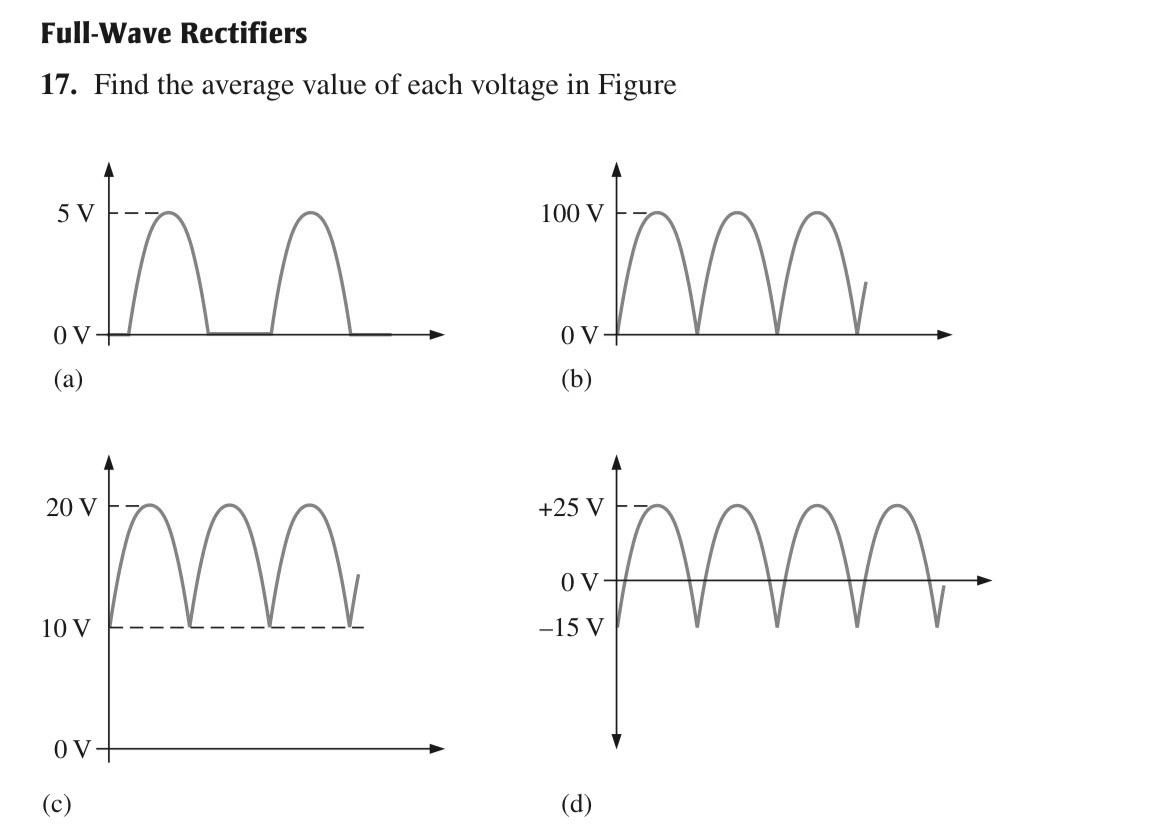
Introductory Circuit Analysis (13th Edition)
13th Edition
ISBN: 9780133923605
Author: Robert L. Boylestad
Publisher: PEARSON
expand_more
expand_more
format_list_bulleted
Question
Please answer all subpart either dislike is ready to you
Please all subpart is compulsory please I am again saying all subpart in short
Please in typing format please

Transcribed Image Text:**Full-Wave Rectifiers**
**17.** Find the average value of each voltage in the figure.
The diagrams illustrate voltage waveforms for full-wave rectifiers. Each graph depicts the output voltage over time, showing the transformation of an AC input into a DC output.
**(a)**
- The waveform oscillates from 0 V to a peak of 5 V. It demonstrates a typical full-wave rectification pattern, with positive voltage peaks and zero-level sections between cycles.
**(b)**
- The waveform reaches a peak voltage of 100 V, with sections returning to 0 V. The pattern repeats regularly, characteristic of full-wave rectification with consistent peak voltage.
**(c)**
- This waveform maintains a minimum voltage of 10 V and peaks at 20 V. The upward shift indicates a DC offset, showing that the rectification process raises the whole waveform above 0 V.
**(d)**
- The waveform ranges from -15 V to +25 V. This graph shows the oscillation of the waveform above and below a 0 V baseline, resulting in both positive and negative peaks.
Each of these diagrams showcases different aspects and configurations of full-wave rectified voltage outputs, key for understanding rectification in electrical engineering.
Expert Solution
arrow_forward
Step 1: Write the given information
Given the four sinusoidal waveforms.
Trending nowThis is a popular solution!
Step by stepSolved in 6 steps with 9 images

Knowledge Booster
Learn more about
Need a deep-dive on the concept behind this application? Look no further. Learn more about this topic, electrical-engineering and related others by exploring similar questions and additional content below.Similar questions
- A conveyor motor has a N.O. START button (I:0/3) and a N.C. STOP button (I:0/4) to start and run the conveyor motor (O:0/4) when the START is pushed and released. When the conveyor is running bottles will pass a proximity sensor (I:0/2). After 12 bottles have passed the sensor output O:0/5 must be turned ON (to have the bottles removed by a different machine) and the counter must be reset. Sketch the program rungs to make this work.arrow_forwardPlease in typing format please ASAP for Thanks ?arrow_forwardChoose the correct instruction that will send data to an I/O device. IN AL, 60 IN 60, AL OUT 60, AL OUT AL, 60 MOV AL, 60 MOV 60, ALarrow_forward
- In R/2nR DAC, the maximum input resistor to be used is Rmin*2^(n-1) where n is the number of bits. Rmin*(2^n)-1 where n is the number of bits. Rmin*2^n wheren is the number of bits. Rmin*[(2^n)-1] where n is the number of bits.arrow_forward• 6.12 Write a behavioral-style Verilog module Vr2to4decp_b for the 2- to-4 binary decoder with polarity control shown in Eigure 6-3. Use a vector I[1:0] for the select inputs, and a vector Y[0:3] for the outputs. Be sure that your code does not create an “inferred latch."arrow_forward
arrow_back_ios
arrow_forward_ios
Recommended textbooks for you
 Introductory Circuit Analysis (13th Edition)Electrical EngineeringISBN:9780133923605Author:Robert L. BoylestadPublisher:PEARSON
Introductory Circuit Analysis (13th Edition)Electrical EngineeringISBN:9780133923605Author:Robert L. BoylestadPublisher:PEARSON Delmar's Standard Textbook Of ElectricityElectrical EngineeringISBN:9781337900348Author:Stephen L. HermanPublisher:Cengage Learning
Delmar's Standard Textbook Of ElectricityElectrical EngineeringISBN:9781337900348Author:Stephen L. HermanPublisher:Cengage Learning Programmable Logic ControllersElectrical EngineeringISBN:9780073373843Author:Frank D. PetruzellaPublisher:McGraw-Hill Education
Programmable Logic ControllersElectrical EngineeringISBN:9780073373843Author:Frank D. PetruzellaPublisher:McGraw-Hill Education Fundamentals of Electric CircuitsElectrical EngineeringISBN:9780078028229Author:Charles K Alexander, Matthew SadikuPublisher:McGraw-Hill Education
Fundamentals of Electric CircuitsElectrical EngineeringISBN:9780078028229Author:Charles K Alexander, Matthew SadikuPublisher:McGraw-Hill Education Electric Circuits. (11th Edition)Electrical EngineeringISBN:9780134746968Author:James W. Nilsson, Susan RiedelPublisher:PEARSON
Electric Circuits. (11th Edition)Electrical EngineeringISBN:9780134746968Author:James W. Nilsson, Susan RiedelPublisher:PEARSON Engineering ElectromagneticsElectrical EngineeringISBN:9780078028151Author:Hayt, William H. (william Hart), Jr, BUCK, John A.Publisher:Mcgraw-hill Education,
Engineering ElectromagneticsElectrical EngineeringISBN:9780078028151Author:Hayt, William H. (william Hart), Jr, BUCK, John A.Publisher:Mcgraw-hill Education,

Introductory Circuit Analysis (13th Edition)
Electrical Engineering
ISBN:9780133923605
Author:Robert L. Boylestad
Publisher:PEARSON

Delmar's Standard Textbook Of Electricity
Electrical Engineering
ISBN:9781337900348
Author:Stephen L. Herman
Publisher:Cengage Learning

Programmable Logic Controllers
Electrical Engineering
ISBN:9780073373843
Author:Frank D. Petruzella
Publisher:McGraw-Hill Education

Fundamentals of Electric Circuits
Electrical Engineering
ISBN:9780078028229
Author:Charles K Alexander, Matthew Sadiku
Publisher:McGraw-Hill Education

Electric Circuits. (11th Edition)
Electrical Engineering
ISBN:9780134746968
Author:James W. Nilsson, Susan Riedel
Publisher:PEARSON

Engineering Electromagnetics
Electrical Engineering
ISBN:9780078028151
Author:Hayt, William H. (william Hart), Jr, BUCK, John A.
Publisher:Mcgraw-hill Education,